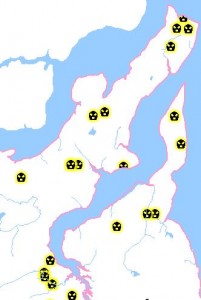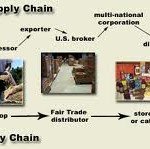An interesting development is now underway with the formation of a citizen’s group to advocate for Public Power – the distribution and generation of electricity by our county’s own public utility, Thurston PUD No. 1. Currently a water utility, Thurston PUD has grown a great deal over the last seven years. We have a staff of 11 to 12 people and operate water systems in Thurston and four neighboring counties.
Going electric requires a county-wide vote in the general election. The citizen’s group, Thurston Public Power Initiative, was established by Thurston County residents to accomplish this goal by petitioning our county’s registered voters to place the issue on this November’s ballot and to campaign for its passage. Their first task is to submit the petition language to our county auditor for approval and collect nearly 12,000 valid Thurston County signatures to place the issue on the ballot this fall. Their deadline to accomplish this is early July.
In 2008, a similar citizen’s group in Jefferson County (Port Townsend area) succeeded in passing a county-wide vote and the Jefferson PUD will soon be entering a three year transition to take control of its electrical service at the end of March 2013. Similar ballot measures that same year failed in Island and Skagit Counties.
This proposal is not new to Thurston County. It first came about with the formation of our own public utility district (PUD) in 1938. The long period of court battles that ensued failed to bring the PUD into the electrical business. Several more attempts were made up to the early 1960’s when one of two supportive commissioners died suddenly, leaving the other hopelessly deadlocked with the third commissioner. Future elected commissioners later overturned the entire effort.
During our PUD’s first 23 years the issue went before the Federal Court and involved several other county PUDs’ attempt to take over Puget Power as well as another private utility. The last eruption 50 years ago even sparked a highly polarized dramatic debate in the state Capitol and led to the removal of the pro-public power and long time Speaker of the House, John L. O’Brien by defections from within his own Democratic Party.
Why the current interest in publicly controlled power?
Our current Investor Owned Utility (IOU) Puget Sound Energy is no longer a publicly traded company with US shareholders. It “went private” three years ago and is now entirely foreign-owned and -operated (though nominally registered in the state of Delaware as a US company). Its new owners are an Australian Investment Bank and Canadian Pension Funds. Their mutual interest in owning our state’s largest private utility comes as no surprise, since Puget Sound Energy is one of the largest consumers of the Canadian Natural Gas Fields located in Western Canada. The resulting match-up along with the existing pipelines could be characterized best as a vertically integrated conglomerate (single ownership of the gas fields, pipelines and the consuming utility). That is where we are today.
I ran for office over three years ago on a platform that including having our PUD commission a feasibility study on whether we should enter the electrical business and how best to pursue this option. I was elected with over 60% of the vote. It is now time to act on this issue and give our citizens a clear appraisal of its prospects.
At our January 10 meeting, I will ask our PUD to commission an independent feasibility study to determine whether we should enter into the electrical business and via what process taking into account our current economic climate. One of the subjects the study will consider is the finite resources of federally-controlled hydropower and our ability to access it before its capacity is all spoken for.
In the future, electric utilities will be more and more involved in our citizens’ transportation choices. Most car manufacturers are fully aware of and working toward this. As demand and cost of generation rises, so will electric rates. Public power provides the opportunity for greater citizen oversight and local control of this resource that is so vital to the overall economic health of our community.
Future electrical rates by a publicly owned utility could be moderated by:
1) Direct access to Bonneville’s (BPA’s) cheaper Tier One federally sourced hydro-power through a hundred year-old federal policy known as “Preference,”
2) Lower interest rates on debt for municipal bonds which are tax-free for PUD’s,
3) Removal of the over 10% return (profit) paid to private utility shareholders as regulated by the Utilities and Transportation Commission, the regulator of all private utilities in our state.
All users – residential, industrial, commercial, and government – would benefit from the historically lower rates of publicly-supplied electricity. One of the greatest benefits of rate relief would go to the commercial and industrial business owners who provide jobs in our county. They are currently unable to take advantage of the small farm/residential exchange subsidy from BPA, so their rates will be most favorably impacted in a transition to public power. Cheaper rates to all forms of government could also lead to additional savings for all our citizens, helping to retain spending on government employment, which is an important sector of our local economy.
Improved system maintenance and operation of our electric utility could provide better overall service without the prolonged seven to ten day long storm-related power outages that leave our most vulnerable citizens helpless – often in the coldest and wettest months of the year. Expansion of locally-based union linemen would bring jobs to our county, assure greater system reliability and shorter down time, and be better able to maintain the grid. Our insistence on using quality (instead of second-hand) components will also drastically reduce the number of currently all-too-common power outages due to equipment failure or blown transformers.
Finally, there are great changes underway as to how electrical energy will be delivered in our future. A decentralized electrical grid composed of local renewable energy generation as part of people’s homes, clustered development, and community-based initiatives could lead us closer to a sustainable future. I believe strongly in a more sustainable future and I have been involved directly in our County’s Sustainability Initiative as the chair of the water panel. More and more, the issues of how our energy is produced, and how far away it is produced, will determine what rates we will pay and what kind of future we will share. Isn’t it time that we, citizens, as electric consumers, have a voice in those decisions being made on our behalf? The decision is in your hands.
– CHRIS STEARNS
Chris Stearns, a resident of Thurston County since 1976, is a Thurston PUD. Commissioner and was elected to his first term in 2008.
Public Disclaimer by Chris Stearns: The views contained in this article reflect my own personal opinions and are not necessarily those of my fellow PUD Commissioners, nor do they reflect the official position of Thurston PUD No. 1, which is a water utility at this time.
This article reprinted without permission from Works In Progress, January 2012.















